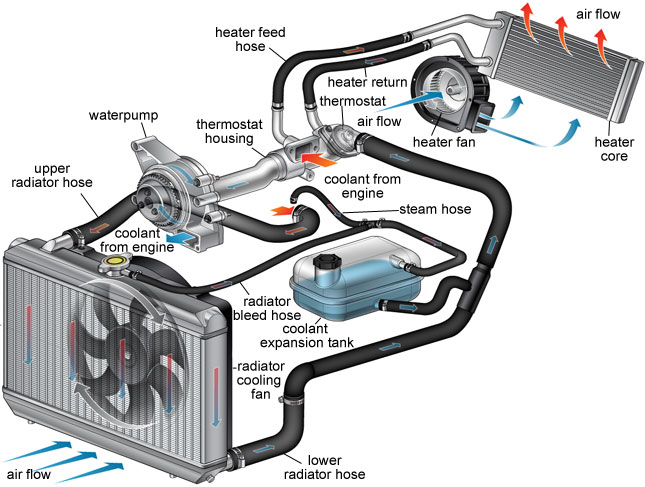Stay Warm or Cool. Your Choice.
Your vehicle’s cooling system is extremely important. It’s what regulates the temperature in your engine and protects it from overheating, damage and breakdowns. The cooling system also keeps your engine from freezing during the winter months.
One of the most common causes of car problems and breakdowns is cooling system failure. A failure in the cooling system can cause severe engine damage. Problems can stem from low coolant levels, old coolant, or leaks. Fortunately, it’s easy to prevent problems by having your cooling system checked and maintenanced regularly. You should have your coolant flushed and refilled as often as your vehicle’s manufacturer recommends. Intervals typically range from 2 to 3 years, depending on the type of coolant and vehicle (see below). Remember, every time you bring your vehicle into a Levin Tire & Service Center, we will inspect the condition and level of your coolant, as part of our customary 32-point inspection.
How Does the Cooling System Work?
Engine coolant runs through your entire cooling system to and from the radiator. The water pump is what moves the coolant through the system. The radiator uses cooler air to bring down the temperature of the coolant. This diagram offers a more detailed look at the process and shows all the parts involved.
Cooling System Diagram
What is Coolant?
Also known as antifreeze, coolant is the red or green liquid in your radiator and throughout your cooling system. Radiators are usually filled with a 50/50 mixture of coolant and water. Coolant is added to the water for the following reasons:
- It keeps the water in your radiator and engine from freezing in cold temperatures.
- It keeps the water from overheating in all temperatures.
- It helps to lubricate the components in the cooling system. Coolant also will prevent the water from rusting and corroding the internal parts of the cooling system.
What Is a Coolant Flush?
During a coolant flush, all fluid in the cooling system is removed. A hose is attached to both ends of the cooling system and the entire system is power flushed and cleaned. Then, a new coolant mixture is pushed through the system (radiator, hoses, pump, engine block, etc.). A flush is different from a simple drain and refill because it replaces all of the old coolant, and flushes out sludge, rust, and dirt buildup. A drain and refill entails only draining and refilling the coolant in the radiator. Flushing the coolant in your vehicle’s cooling system is a great way to help maintain a healthy engine.
Why Does Your Vehicle Need a Coolant Flush?
As coolant gets older, it begins to lose its protective properties and doesn’t do its job as well as it used to. Sludge, dirt and rust can also buildup in the cooling system which can cause a blockage in a hose or line. Having fresh coolant and a clean system better protects and cools all components.
How Often Does Your Vehicle Need a Coolant Flush?
There are a number of factors that determine how often to have a coolant flush, including:
- The size of the engine
- Your vehicle’s mileage
- The climate you drive in
- The age of the current coolant
- The type of coolant in your system
- The manufacturer’s recommendation
Most vehicles require a coolant flush every 24,000 to 30,000 miles, or every 2 to 3 years, whichever comes first. Check your owner’s manual to see what your vehicle’s manufacturer recommends.
In addition to time and mileage, a change in the coolant’s color may indicate it needs to be replaced. Also, by using a simple tool called a hydrometer, you can check the ratio of coolant to water. If the amount of coolant is too low, it’s time for a change. (Note: Never remove your radiator cap while the engine is hot; it can cause severe burns!)
If it’s time for a cooling system flush, pull into the nearest Levin Tire and Service Center and we’ll be glad to do the job for you.


Leave a Reply